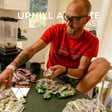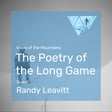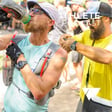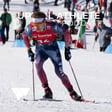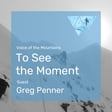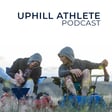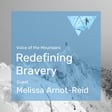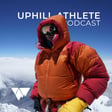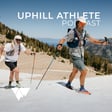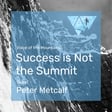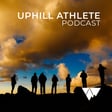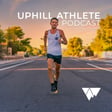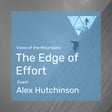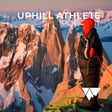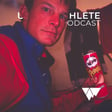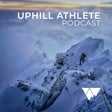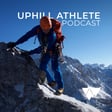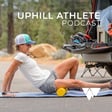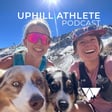Introduction & Motivation
00:00:00
Speaker
Choose objectives that scare you. It means it's probably big enough. I think if you think of something and you're like, oh, you know, that's easy, I can do that, then it means, is it big enough? I was scared for the triple, you know, until the day we did it, I wasn't sure.
00:00:22
Speaker
If you're enjoying the show and want to take the next step in your training, join our newsletter and receive a free four-week sample training plan. Head on over to uphillathlete.com slash let's go. And once you sign up, you'll instantly get a link to try out some of our most popular training plans.
00:00:39
Speaker
It's a great way to get a feel for how we train our athletes for big mountain goals. Check it out at uphillathlete.com slash let's go. uphillathlete.com slash L-E-T-S-G-O.
Meet Laura Pinot & Her Climbing Journey
00:00:56
Speaker
Welcome to the Uphill Athlete Podcast. My name is Alyssa Clark and I will be your host today. On June 8th, Laura Pinot, hoping I'm saying that right, um ah Pinot?
00:01:08
Speaker
Yeah, perfect. you know Okay. And Kate Kelligan became the first woman to complete the Yosemite Triple Crown in under 24 hours. A monumental feat of endurance, Kate and Laura set a new standard for women in climbing, and I'm so honored to have Laura with me today.
00:01:25
Speaker
Laura, also known as Mademoiselle Fissure, which I want to get into, is a French professional climber for La Sportiva among Coros and a few other companies, and also is a climbing instructor from what i for my research and just an all-around badass. So Laura, thank you so much for being here with us today.
00:01:44
Speaker
Of course. Thank you for having me. can't wait to talk to you today. Yeah. Well, first off, I want to hear about Mademoiselle Fissure. Where did that come from? i have a guess, but I'd love to hear about that nickname.
00:01:59
Speaker
Yeah, this is a funny nickname that I chose last November because I was working on this hard crack in Valle Orco, Greenspeed, in Italy. and And was climbing with my friend Paolo, who is Italian.
00:02:14
Speaker
And he was also speaking a little bit of French and kept saying, oh mademoiselle, mademoiselle. And then one day, I don't know how it came out. ah He said, Mademoiselle Fissure. And I was like, oh, that sounds really great. You know, it's a mix of crack, which I love. And then it's a bit of French, Mademoiselle.
00:02:30
Speaker
So that's how i was like, oh, that's a cool nickname. Let's just use this as a funny way to describe myself and where I want to go, because I'm definitely a crack addict. You know, I love climbing cracks all around the world.
00:02:41
Speaker
And this is definitely a new passion of mine that I've had over the past two years. And I thought this was just a ah cool nickname to have. Oh, I love that. Well, I mean, the way that I was kind of first introduced to you is that my husband also loves crack climbing and had reached out to you of like, hey, I'm going to be in Chamonix. A, do you want to climb? um And B, like any cracks, because he was so ah excited that you love to crack climb. And i guess that's not as common for French climbers to be kind of as as much interested in the the crack side of things. so
00:03:18
Speaker
Yeah, you're definitely right. I think for French climbers, we have world-class limestone sport climbing all over our country, tree and and we have amazing bouldering as well. So I think, you know, most people, if you live outside of the Alps and you're not really close to Chamonix that has beautiful and amazing cracks, then you're definitely way more exposed to bouldering gyms and to...
Crack Climbing & Mentorship
00:03:38
Speaker
Limestone sport climbing. So that's how I started climbing. I started actually above the water on limestone, deep water soloing, but then I was exposed to limestone sport climbing more. And that's what I've had most experiences on, especially as sport climbing.
00:03:53
Speaker
And then i did my college degree in the US. And then after my college degree, I had a one-year work visa. And that's when I bought a van, worked remotely, traveled all over the U.S. until I arrived in Moab.
00:04:05
Speaker
And that's where I met this professional climber, Brittany Gores, who spent time showing me how to climb cracks and really was an amazing mentor to me on how... you know, how to place gear, how to fall net, how to be comfortable, because everyone has a vision of track climbing as something, oh, it's so scary. It's so dangerous. You know, everyone reps gear all the time and it's it's so not true.
00:04:28
Speaker
And there's so many ways of learning track climbing really safely. You just need, I think, to find a really good mentor, like mentor, And someone who will take time to show you slowly how to do it and who won't pressure you to go on harder climb than what your level is in a way.
00:04:45
Speaker
And I thought Brittany was amazing to me for that. And, you know, sometimes I'm trying to teach other people how to crack climb and really take time with them and be like, okay, like, remember when you were a beginner, hand jams were hurting your hands.
00:04:57
Speaker
So you can't climb as much as you can climb now two years after learning how to crack climb. And yeah, when you when your husband reached out, it was so funny because I was like, oh, amazing. Other people who love cracks. And whenever I'm traveling around, I'm always so happy to, you know, meet other crack lovers and and go climb with new people, because I think that's what makes sense the climbing community is so special.
00:05:18
Speaker
It definitely does. And I mean, you've already jumped into a couple of questions, but I was curious how, well, first of all, deep water soloing, that's not something that everyone's like, yeah, I deep water soloing, got right into
International Climbing Experiences
00:05:32
Speaker
it. So how did uh,
00:05:36
Speaker
learn about climbing? Was it in your family? Like what was your background as a child? yeah It was definitely not in my family. So when I was younger, I did, you know, seven years of tennis, probably to spend time with my dad and and do the same thing as my dad. And then I switched to boxing, English boxing for two years, which my mom kind of got me into it because she knew i was not liking tennis anymore and was like, okay, we got a find a new sport. So did boxing. And then one day, one summer, ah used to go to this place in my hometown called Saint-Père in Toulon.
00:06:06
Speaker
And this is a place where most teenagers go and they cliff jump or they go swim. They hang out with their friends. It's like paradise for summer location. It's really a gorgeous place. And one day I met this climber, Fred,
00:06:18
Speaker
And he was like, hey, like if you want to go climb, come, I'll show you how to climb and I'll show you around. So for four hours, he took me along the coast and showed me all the different sections, where to put my hands, explained me the movements.
00:06:31
Speaker
And then every day I was going back to do the sections I was falling into what the water and I couldn't do. And I was just obsessed with like, okay, one more moves, two more moves. I know I can do it. I'm so close. And then, you know, i was not great at it. And even him, he was like, oh, like she's not good at it. Like, where is she going to go? That's what he told me years, you know, years after he was like, oh yeah, you know, you were not really great those first sessions. and But of course, you know, who's great on session number the one above the water climbing? You know, it's not an easy discipline and it's it's pretty scary to be high above the water.
00:07:04
Speaker
And then another friend was like, OK, if you want to get stronger and come back to do more next year, you should go in a bouldering gym. And then that's how I signed up in a bouldering gym in September after the summer. And I was hooked and then never stopped since then.
00:07:21
Speaker
That's amazing. Wow. I mean, that's such a fun. I've always wanted to deep water solo. I think it sounds amazing, especially we used to live in Hawaii for a little bit. like Oh, nice. Yeah. so You should go Mallorca.
00:07:33
Speaker
I think Mallorca, no better place for deep water sailing. Mallorca is beautiful, amazing. And you can just rent an apartment in one of those little cities and then you walk a little bit and there's so many cracks for deep water sailing and so many that are really close to the water.
00:07:48
Speaker
You know, this, but you see all those big cliffs on media that are super high, 15, 20 meters high. where most people wrap into it and practice on the road before even doing it. But then you have all of those other little crags that are super close to the water, super safe, and just an amazing summer vacation. Like when you do a break from running, I think it's perfect location for you to go in and deep water solo for sure.
00:08:12
Speaker
Awesome. Yes. High on the list. Do you think that there is something... Because with deep water soloing, I've heard this said before that there is kind of this desire not to fall because you have like everything gets wet. You kind of have to restart.
00:08:28
Speaker
It's a lot more effort than, say, taking on a top rope or falling off a sport climb or something. Do you think that um perhaps that foundation maybe influenced your speed climbing later where it's like, yeah, we just don't really fall.
00:08:44
Speaker
It's not really a thing. Yeah, that's a very interesting perspective. i would say, so me
Yosemite Challenges & Achievements
00:08:52
Speaker
personally, as a climber, I've always loved challenges that are super scary.
00:08:56
Speaker
is i don't know why yet, and I'm not sure I totally understand why I'm chasing those scary objectives, but I did the first female ascent of the roof of Saint-Père, which is like thirteen b roof,
00:09:08
Speaker
like roof climbing that's maybe 40 feet above the water and you are upside down. So your back is fully horizontal when you're climbing. And deepwater soloing is extremely scary because if you fall on your back, you could just, you know, like have holes in your in your lungs or injure yourself really badly. And so deepwater soloing, you never go. And I think it's maybe the same mentality with speed climbing. You never go 100% to your abilities, at least that's how I was doing it. You always go all the way to like 95.
00:09:37
Speaker
And when you feel like you're close to falling and you're going to let go, then suddenly you let loose your feet just to be straight up hanging. And then you fall controlled, like controlled in a controlled manner.
00:09:48
Speaker
You never want to fall unexpected. I mean, some climbers do, you know, at the top, top elite level where they just do a huge dyno and sometimes fall on their backs and they're fine depending on how high they are.
00:09:59
Speaker
But with deep water swimming, you want to be super you know, super cautious on how you're falling into the water and how you're landing. And I think that's exactly the same with speed climbing. I never went 100% speed climbing. I was maybe out of breath and my cardio was very high.
00:10:13
Speaker
But in terms of climbing movement and how I was in control, i was never 100%. I was always, you know, at 90%. And you know that, you know, okay, if you get too tired or you have cramps or you're starting to get tired, how I was on the triple, on the boot, for instance, which is really overhanging crack, then I just place more gear to be, you know, a bit more cautious.
00:10:32
Speaker
But you you never go 100% or above your limits. You always want to stay a little under just so you keep the safety margins, you know, in reason and you want to be safe. Yeah, no, that's, that's super interesting.
00:10:46
Speaker
Um, yeah, it's honestly, it's pretty similar with ultras at least for half or three quarters, you are kind of like constantly playing with that effort level being like, okay, if I just like absolutely send it, if I go to a hundred, I am going to be walking or like sitting or dropping from this race. So you really do have to play with that effort level a lot.
00:11:09
Speaker
um But the my other kind of question about background. So where did you go to school in the U.S. s and what made you want to come over here for school? Yeah. Yeah, so I think when I was 17, I went to see someone to help me understand what my work skills were and, you know, what kind of school I should do because I wasn't sure.
00:11:29
Speaker
I knew I wanted to go into a business school, but I was a bit scared I wanted to do this with regards to my dad and um in a lot of ways. You know, i had done tennis because of this. So I was like, okay, I want to make sure it's not for the bad reason that I want to go do that. And I think when I was 17, I realized, oh, you know what? I just...
00:11:47
Speaker
I want to do my studies in English and I want to have an international experiences. Either it's in Europe, in another country or even abroad further. And that's when this woman really helped me find different schools ah abroad, like some in Canada, some the one I went to in the US.
00:12:02
Speaker
some in Italy, some, I think so one was in the UK as well. And the school I chose was called HALT. And it's because this school had a dual degree that would be valid in Europe and in the US. So that was kind of important for me to have.
00:12:16
Speaker
I mean, i'm not that it does matter in the future when you go in the work world, I don't even think they look at, oh, is it valid in Europe or in the US? But for me, it kind of had an importance. And I was going to study with 100 different nationalities of students.
00:12:30
Speaker
And I think that's what really attracted me. I wanted really the the global influence and to you know study with other people from different cultures. And that's when I really learned that you don't talk the same way to a Brazilian that you're going to talk to ah a Japanese friend, that you're going to talk to a European friend or French friend. you know We all interact very differently.
00:12:50
Speaker
And that taught me a lot about the world and how to interact with other people in a lot of different ways. and And then, yeah, after I had this one-year work visa and that's when I lived in a van for summer and i was like, oh, you know what? I really do love van life. So I'm not going to rent an apartment in September and I'm going to keep living in the life and keep being next to beautiful climbing places. and I really perfected my art for outdoor climbing. And I found cracks where i was like, wow, I'm a beginner again. You know, after ah four years of climbing, being a total beginner again and a full Gamby was just amazing because you rediscover the sport. You get to learn new movements, new techniques.
00:13:28
Speaker
And I'm someone who's like, who's in love with learning new things, new processes, new ways of climbing. who loves learning from other people. Like I learned from Kate how to speed climb. I had almost zero climbing experience. So everything she taught me, i listened to it, I applied it. And then eventually you make your own little sauce at what you prefer doing because everyone has different ways of doing it.
00:13:49
Speaker
um But I just love all those so new learning experiences.
00:13:54
Speaker
that's I mean, that you know we I brought up Vitaly when we were talking before we started recording, and he's so similar. I mean, he's just really invested in the learning. He's so humble and just like always thinks he has more to learn, which we all do. I mean, I i said about I've been in the the trail running industry.
00:14:16
Speaker
space for about 10 years now and I'm like I'm just I'm just getting going I'm like just learning yeah so I think keeping that curiosity and that passion for for new endeavors and climbing is so exciting because there's so many pieces to it there's so many avenues you can explore um but what drew you was it just like Yosemite is the mecca I'm gonna end up there someday or like what drew you Yosemite eventually Yeah, so my first Yosemite experience was when I did my first two years I was studying in San Francisco.
00:14:47
Speaker
And so I had a boyfriend
Training Strategies & Techniques
00:14:49
Speaker
back then who was in love with Yosemite and who took me to Yosemite. And that's when I really did my first multi-pitch. I did my first like trad lead, but that first trad lead did not go as well because back then I was still 19 years old and I was very reckless.
00:15:05
Speaker
very impatient climber and person in general. And I was like, okay, just show me the gear. Okay, that's how it's done. Okay, let's let's go climb. I'm ready to lead. And my boyfriend was like, no, I think you should you should take time and we should go slow. And i was like, no, no, don't worry. I got it. Let's go. And then I got really scared on Munginella, which is a 5'8", one of the easiest climbing in the valley, you know, and it just, there was so much rope drag. I wasn't sure of any of the gear You know, I felt so scared. And since then, I hadn't tried climbing anymore. But I knew the first time I saw a captain that I was going to climb it one day. I didn't know when or how much it would take. But already back then, I wanted to climb it. It's just that life kind of went in the way. I got scared on this first track climbing experience, which didn't leave a good, you know, a good...
00:15:49
Speaker
um It definitely didn't leave a good like positive memory in my mind. That's why maybe I didn't really go back to, but I was i was also really focused on studies and I couldn't just go every weekend Yosemite to climb there. And that's when I was like more training indoors and that was just easier for me.
00:16:06
Speaker
But then when I learned how to try climb again in Utah, I always had in my mind, okay, if I learn how to try climb, I need to go back to Yosemite. and I need to climb El Capitan. And Brittany, the one who actually showed me how to track climb and who's my who was my track climbing mentor, she is also the person who told me, Laura, you can totally go do free rider on El Capitan. like You have the level, go do it.
00:16:29
Speaker
And so when I went back, so I learned how to track climb, I think in September, 2022. went for my first real Yosemite season in April 2023. And when I arrived, I could barely climb 5'9", 5'10", without being so, so scared on my first week.
00:16:46
Speaker
And that's when I suddenly became so humble. And I was like, okay, like, granny climbing is a whole new world. I had never climbed on it. I'm arriving in Yosemite Valley. It's really sandbag, old school.
00:16:58
Speaker
like slippery granite, like slippery granite. So I was like, okay, I think it's going to take me a bit longer than just one season to climb El Capitan. and And so i took this first like two, three weeks to learn how to haul, learn how to jog on a rope because I had switched my objective from free rider to the nose. Because I'm like, okay, there's a reason why everyone starts with the nose. you know It's because it's maybe the easiest big wall and a great one to learn how to do it.
00:17:24
Speaker
And so I didn't have a partner to do it. I went around the valley, asked people, and I met this Quebecois guy from Quebec, ah Gab, and he was as psyched as I was. He just had six days left and I had like two weeks left and we've never climbed together. But we're like, you know what? Let's just give it a shot. We'll go to the first four pitches. And if we climb well, if we do it, then we'll keep going the next day. And the first four pitches, we did them in four five hours, which is pretty decent speed.
00:17:52
Speaker
they We were excited. And so we kept going and we had like two amazing days of climbing. and He was one of the best climbing partners I've ever had. He was so patient, so nice, so sweet.
00:18:04
Speaker
And I felt like he was 80% ready for that big wall. I was 80% ready. And then we kind of combined and shared skills that we had developed over the past few weeks in Yosemite and kind of just made it work until we arrived to like Peach, maybe like 15, 16 and two Italians wrapped ah before us and we're like there's a waterfall coming down changing corner we couldn't keep going and they had like Rain jackets, rain pants, they were repelling so fast. and me And me and Gab had only one whole bag. We didn't have any rain gear. The next day they were announcing a storm. So that's when we're like, okay, let's back off.
00:18:41
Speaker
We should really go down and wrap down because we're we're not doing well. And the next day it it could have rain, which it did rain. So thank God we went down because we had no rain gear. We would have maybe been fine. But if you're up there and it's super windy and you're wet and you don't have any rain gear,
00:18:56
Speaker
that could be very dangerous and potentially you know death issues as well. ah So I think it was just the best goal back then to go down. And for me, this was the best big wall experience I've ever had. like I felt like I was floating on a cloud after ah had just really found what I was meant for and I was meant for big walls and that's what I wanted to do.
00:19:16
Speaker
And even though we didn't top out, which didn't matter, just the whole experience was so amazing, slipping up there, You know, looking at a sunrise, looking in the sunset, being on the wall was just such a beautiful moment in life that I was like, okay, this is this is what I'm going to come back for. And I have much more to learn to then, you know, get to the top of l Capitan.
00:19:36
Speaker
Oh, I love that. It's so... It's such a gift to find the thing you're meant to do. I mean, I don't think that that, I think there's a few people in this world, but not that many who get to experience that where you're like, oh my gosh, yeah, this is it. I know it.
00:19:53
Speaker
um That's, yeah, that's amazing. So I read ah in i read the the climbing article. i will link it in the show notes. yeah Sorry, there's an airplane going over. It's an amazing.
00:20:06
Speaker
article and it said that you had gone and done or backed off free rider, um had then attempted the nose. And then you went to Squamish and you started like a really intense training program.
00:20:23
Speaker
What did that training program? Cause uphill, we talk a lot about kind of the education, the training behind it. So that's something I really would love to, do to dig into with you. Um, so yeah, what did this training program look like? Was this someone that something that someone was writing for you? Did you come up with it? Um, so yeah, I'd love to hear about kind of, okay, I know I love this now. How am I going to get better?
00:20:46
Speaker
Yeah, that's that's very interesting. I'm not sure exactly what Sam ah wrote about this or friend Sam who wrote this amazing article and we love her for this and she put so much work into it. But I think it's it I didn't have any training program or a trainer. I just knew what skills I needed to be able to free free riders. So I needed to be strong at bouldering.
00:21:08
Speaker
I needed to be able to slab climb on granite, which I was so afraid of. And when when you've never done it it, it can be super scary because it's just friction. There's no hands. I needed to be good at off-width climbing, which I had never done before.
00:21:22
Speaker
So I practice off-width. I practice bouldering to keep really, like... strong, like to keep strong fingers, because there's a lot of like this, the border problem. And then you also so have the injury corner, which can be a little crimpy, not that much.
00:21:36
Speaker
And then I just need to climb a lot of cracks to get exposed to more granny climbing. So that summer, I just, you know, spend time working on those different skills, getting better at them, because I identified my weaknesses. And Sometimes in climbing, I'm not sure how other climbers do it, but me, it's like, I can spot what I'm bad at. For instance, recently I spot my new one. It's, I'm not a great chimney climber. And I was like, oh, you know what?
00:21:59
Speaker
I'm not good at chimney. Let's go climb chimneys. Like, let's go do stick south and Yosemite and get better at it. So it's like, you know, spotting what you're not great at because when you want to climb so so in a place like Yosemite, you need to be a great overall climber. You need to be good at bordering moves. You need to be good at crack climbing, finger cracks, off-width cracks, chimney cracks, slab climbing, you know, face climbing. Like you have a bit of everything, which is why I love Yosemite because from the first moments I knew that, oh, if I climb a lot in Yosemite, I know I can be a really good overall climber and I know I can learn a lot from that place. So I think...
00:22:33
Speaker
You know, I didn't have a very precise training program, but I just really worked on all those separate skills that make you a better crag climber. And that would help me get ready for definitely for free rider.
00:22:48
Speaker
So when you were, first of all, that is an incredible skill to have to be able to recognize your weaknesses. I actually, well, I think people are okay at recognizing their weaknesses, but then to dig in and actually work on them is the I think the difficult part.
00:23:06
Speaker
But when you were say organizing your week, Would you be like, hey, this week I'm going to focus, ah like, would you cycle through? Would you be like, hey, I'm kind of just working off of partner availability? Like, how did you decide what you were going to focus on? And was it, um hey, I'm just going to climb really hard?
00:23:26
Speaker
Or was there, I'm going to focus on volume. I'm going to focus on, you know, finger strength, et cetera. Like, how did how did you um manage that or organize that?
00:23:39
Speaker
I think mostly me, what I've always loved doing, especially when I live in a van and I'm somewhere and I climb outdoor mostly, is to do two days on, one day off. And usually i would always prioritize my first day on to be maybe like bouldering or bit like more powerful routes, like harder on the fingers or harder on your body, just so you're ready.
00:23:59
Speaker
and then have a second day where it's more focused on volume it could be multi-pitch it could be going at a sport climbing route ah like sport climbing crag and do as many routes as i can i think that's how i would organize it from what i remember ah right now i'm trying to definitely get a new climbing coach and have a bit like more organized training especially after all the speed climbing i've been doing i think it's important to get back into it in a really smart way, not too hard too soon, because that's always, you know, the issue is when you haven't climbed hard in a long time, you need to really take it slow at the beginning.
00:24:32
Speaker
But back then, you know, I was living in my van, working remotely, climbing two days on, one day off. um And just, you know, depending on partners as well. And one thing I'm like, I really try to always focus is that like sometimes I'm really good at seeing in people what they're good at. For instance, you know, maybe i have my friend Nate. He's an amazing chimney climber.
00:24:51
Speaker
Okay, let's go climb chimneys with him because I know by looking at him climbing, I'm going to learn a lot on movements and how he climbs them or let's go climb with my friend Sam, who's an off-width professional and who loves off-width. So I went off with climbing last fall with her and I seeing her on that off-width roof climb that we climbed together. I was like, whoa, like she's a wizard. Like how does she do it? And, you know, learning new skills from her or, oh, let's go climb with my friend Jacob Cook. yeah Like he's an amazing stack climber and maybe I can learn from him on like how he places this his feet, what shoes does he use, you know? So I think if you can really see that in your friends and seeing what they're good at that maybe you're lacking, then it's a great way to get better at it without having to just, you know, it's not just always about strength and getting stronger and always being strong. There's so much about technique in climbing. And I think if you can learn from those other people that are really great at it, I think it's a great way to get better yourself.
00:25:50
Speaker
I love that. I mean, gosh, you have a lot of wisdom. Seriously. i mean, that's yeah. I mean, that's huge and so accurate. um So let's
Nutrition, Hydration & Performance
00:26:03
Speaker
see. go and you improve on these skills. And then do you go back to Yosemite?
00:26:09
Speaker
Oh yes. Yeah. I went back the same fall. Yeah. So I spent, I think I spent two months in Squamish and I went back in October Yosemite and just had the best season ever. It was really special. And I think for two weeks I climbed in Yosemite.
00:26:24
Speaker
i did a lot of like 5.11, 5.12 routes just to get better, see how I was feeling. I kept doing some bouldering sessions and I was doing a lot of V8s that I had not done before. So I was like, okay, like, yeah, my bouldering strength is really good. i feel really good on climbing routes.
00:26:40
Speaker
And then after two weeks, we just, with my ex-boyfriend, Mike, we just packed our bags, packed everything and then just went for it. And so I would have never sent Freerider without him. Like he's He knew so much about wall logistics, how to, you know, how to haul a bag efficiently, how to go up on the ropes, how to, how to just like also get food in your system. You know, at first he was packing the food and he was like, oh, like what food are you taking? I'm like, I don't know. Like I'm following you. I don't know what to take. You know, I don't know what's the best. You know, he was like, oh, okay. Like usually everyone packs their own food.
00:27:13
Speaker
But then he was like, oh, OK, then I guess I'll be packing for two. you know So he really helped like pack the whole nutrition. He also taught me about like how to drink electrolytes on the wall because electrolytes are key. And I learned a bit more about electrolytes even after him because back then I thought, you know, electrolytes are just good when you're doing something big, but it's so untrue. And I've been drinking electrolytes almost every day. And it's been a game changer for my hydration in general. So I don't think it's just...
00:27:40
Speaker
ah um I don't think it's something extra just for big days. I think even on normal days and normal training days, you just need extra electrolytes. And I'm someone who, after doing a few tests, realized um I'm a very like so ah salty sweater. And so I need more salt than the average ah person as well. And so ah after doing this, I felt a huge difference in my climbing.
00:28:01
Speaker
And so you know having him as a partner for Freerider really allowed me to do it because for so many of the pitches that were white pitches, chinnies, Some of them he did. And, you know, and then I just followed without falling.
00:28:12
Speaker
So was definitely a big partnership experience, ah which was really so valuable and seven days on the wall, you know, which was crazy. And even the whole way that we strategize, we took a rest day on day three after climbing the off-width, the monster off-width, because it takes so much energy out of you that taking a rest after this was so key for us to be able to keep going and do the boulder problems on day three on day four or five.
00:28:38
Speaker
ah So yeah, big, big mission at El Capitan. And then that was my first time you know freeing a route on Capitan and topping El Capitan at the same time because I hadn't topped it out when I when i just hit the nose.
00:28:51
Speaker
ah That's amazing. So yeah, the electrolytes, I think it's so, i've that's been mike my my ah hill to die on this year. is Because honestly, it affects your food. And for climbers, it affects like your skin quality, your salt. you know It's just all of it is so important.
00:29:12
Speaker
And to me, it's insane that we like I mean, ultra running is in the same boat where it wasn't until basically this year last year that people were like, oh, that matters? Oh, you know, just like randomly drink water? Now it's crazy. Really? was but is it Is it this early though for ultra running?
00:29:27
Speaker
People weren't doing this before? Or not everyone maybe? really there would There was no like... I mean, maybe people would do the volume test, but they wouldn't do the salt concentration. And so they wouldn't really know what... You'd have people who were maybe...
00:29:43
Speaker
you know, 500 milligrams per liter and actually they're 1500. And so people would get such issues with their stomachs because your salt is so off.
00:29:54
Speaker
Yeah. So this year, i think, I mean, Precision has done, i think, an incredible job of making sweat testing accessible. And there's other you know universities, et cetera, that will do it.
00:30:07
Speaker
But I have multiple friends and clients that have gotten it done. And it is just eye-opening, really. Oh, my gosh. Like, yeah, that's a huge difference in what we thought. So, yeah, I'm glad that you were.
00:30:20
Speaker
Yeah, especially when you take it daily, me, I could feel a huge, huge difference. And now when I don't have any electrolytes and I need to order new ones and I'm missing them for a week, I'm like, oh my God, how am I going to survive? I need them, you know? And I've always, also being someone who puts extra salt on her food and my mom has always joked with me like, like stop putting salt on your food. It's salty enough. But I'm like, no, it's not, you know, like I'm I've always felt like my body needed more. And I thought, oh, maybe I'm just addicted to salt. You know, I don't know. And then when I talk to, you know, the scratch labs and they explain me, oh, no, it's probably because you have a high concentration in salt in this one liter of sweat that you need more. And so that's why you've probably been putting more salt because your body was telling you to do that.
00:31:03
Speaker
which is so interesting. Like your body knows and sometimes you're just doing things without really understanding why, but you're like, i know it's good for me, so i'm going to do that. And I've always done it. And so now that I'm taking electrolytes, I'm like, oh, you know, it all comes together and makes sense on many levels.
00:31:19
Speaker
Yeah. No, a hundred percent. I mean, there's kind of the old school way of when you come up to an aid station and ultra running, um they'll have often like M&Ms or like fruit or, you know, kind of this the sweet, and then they'll have pretzels and chips and the salty. And so we always like kind of the old school way before we started getting the testing was whatever you you just like reach for it without thinking is probably what you need. Like, oh, you're low on sugar. you're going to reach for the sweet. If you're low on salt, you're going to reach for the salty. And so, yeah, your body does do, I mean, for all the testing and everything, your body does do an incredible job of telling you what it needs.
00:31:56
Speaker
um I salt everything as well. Yeah. nice Our, our family members who are um not quite as like, you know, endurance based are always like, Oh, there's so much salt on this. I'm like, I don't know.
00:32:10
Speaker
This great. i was So funny. No, that's amazing. So yeah, you definitely do understand. And it's same for big walls, you know, and, and okay. The new thing now that Kate and I discovered a bit more for the triple, because so when we did the triple, we were so focused on nutrition and hydration and how to get like the
The Yosemite Triple Crown Challenge
00:32:32
Speaker
right nutrition and hydration, especially knowing that we'll be doing a 24 hour day. So how do we prepare all the stomachs and how do we prepare for the race? So we, we were,
00:32:41
Speaker
climbers, but we train as like ultra runners or we climb as ultra runners, especially for hydration and nutrition. And so we also put high carbs into all of our big world waters. So we, every time we we're drinking water bottle, we had electrolytes in it and high carbs and me, ah that was perfect. You know, digested well for K2.
00:32:59
Speaker
And then we also discovered me, I discovered that I liked the gummies more, you know, high carb gummies, her, she liked more the high carb bars where me bars, I was like, oh, it's you know After one, it's so disgusting and I didn't feel like eating much more. But with gummies, I could just pound two, three, four little bags and it was really easy.
00:33:16
Speaker
So just like trying to test. like We did a lot of testing on like, okay, like how much high carb do we put in the water? or How many scoops of electrolytes? And then how many bags of gummies are we taking? How many bars? Because we're counting them down for each wall. We had a certain amount. And on the triple, we maybe added one or two bags just in case to have a bit extra because we wanted to keep eating and more.
00:33:37
Speaker
to sustain for that day. But that was really big for us too, for our strategy to you know do well during 24 hours. Yeah, I'd love to... Yeah, let's just dive into that. um First off, though, we've thrown around the term, the triple. Yes.
00:33:55
Speaker
The triple, do you want do you want to do you mind giving the, like, Cliff Notes or version of it? Yeah, oh of course, definitely. I think the triple is a challenge that was first done by Dean Potter and Timmy O'Neill back in 2001. It was...
00:34:08
Speaker
Dean Potter's idea and he kind of kept it a secret because we interviewed Timmy. So Timmy gave us all the little details about the triple. And since then, 10 other teams of men have done it. And so this challenge consists of ah climbing Mount Watkins, El Capitan and ah Half Dome in Yosemite Valley in California.
00:34:30
Speaker
And this is just a big endurance pit, ah like, you know, big endurance challenge because it it consists of 71 pitches and we're climbing about like 2,500 meters of elevation of gain climbing, but also 2,200 meters of elevation gain hiking.
00:34:48
Speaker
So it's a lot of hiking in between each mountain. we We did it supported. So we also had, um we we were driven from Watkins to the base of El Capitan and then from ah Capitan to the base of the desk labs to then do Half Dome.
00:35:04
Speaker
And what was crazy about that day is that you know we did it fully supported with like 15, 20 people helping us. So we we're full on ultra trail challenge. you know I had never done something like that. For me, it was very new on many, many levels, even managing 15 to 20 people and making sure everyone is at the right place, right moment.
00:35:24
Speaker
text the backpack that you need to be taken at the right time, knowing that we're not 100% sure at what time exactly we're going to arrive. Are we going to be ahead of schedule or behind the schedule? It was an all sure. So it was it was a big learning experience that I can say. And who made it that like 24 hours is the like official time for it?
00:35:48
Speaker
Yeah, that's that's a great question. I think it's a Yosemite game that's been here for you know a long time where people are like, oh, it's great if you can do a challenge in a day. It means you're car to car in a day and then you go home and then it's done. So I think challenges in Yosemite historically have been done in a day or it's always been the challenge um for for the climbers who have been there before us, like women and men.
00:36:15
Speaker
And i also think that all the men who have done it before us, including Dean Potter and Timmy O'Neill, like I think we beat the record of of team and d and ah Dean and Timmy. It's funny because they did in 2350 with something really close to 24 hours, but still did it in a day. So they were really psyched, but that was really, really close.
00:36:34
Speaker
And so as the timer and for the others too, the timer starts when you start ah climbing on Watkins because it's a four hour hike almost to get to Watkins. So it's a really, so this is your warmup.
00:36:46
Speaker
You know, you already get like 700 meters of elevation. You do already 10 kilometers and you do, you know, three and a half, like four hours of hiking to the base of Watkins where we did it as slow as we could to not get tired. So we were going really slow.
00:37:02
Speaker
And just so you know, on every hiking section, we had friends or family members that were carrying all of our gear. We were not carrying anything on the whole day, like T-shirt, squirts, maybe extra food and then nothing else, which felt amazing and was another reason why we were able to do it under 24 hours.
00:37:19
Speaker
And so clock starts when you start climbing on wetkins. Then you climb it, you do an hour hiking, you an hour driving, 20-minute walking to the base of the nose. You climb the nose. We did seven hours, 25. You hike down. We run down the nose to gain time. i was wondering if you ran.
00:37:36
Speaker
yeah So we were on schedule, but it's... For us to do it in 24 hours, we were not this fast climbing that it would need to all go perfectly fine. Like it needed to be a perfect day with no issues, no problems or small ones. You know, if we had a 20 minute issue somewhere, we'd have done above 24 hours. And I think our first goal was to do it in a push. But deep down,
00:38:00
Speaker
inside us. We're like, no, we need to do sub 24, like all the other guys beat like before us. We were like, this is the challenge. Those guys did it this way. We need to do it this way too. Like there's no other way. Even though, you know, like story could have been different, but we knew that we needed to have such a perfect organization. We needed to have plan E, A, B, C,
00:38:20
Speaker
and be ready for things going wrong to just, you know, adapt to it and react fast to it and not lose time, which turned out to be real. When we topped out the nose, I felt like we were going way slower, but we're still on time with the schedule. And so our friend, Nicky,
00:38:36
Speaker
run down with our gear with us. And he really set a really fast pace. And I think me and Kate were both maybe, yeah is it going, you know, is it going to ruin the next few hours? Cause we still had eight hours to go. You know, it was not over eight or nine hours to go. So it's the day's not over, but we ran down super fast. Everyone at the cars were like, Oh, you guys already here? Like what what's happening? like it's been 40 minutes since you topped out. And so then we rushed into the car, drove 20 minutes.
00:39:02
Speaker
And then another time where we, ah cut down time was the desk lap to get at the base of Half Dome. You have still a thousand meter of elevation gain, and which is not nothing.
00:39:13
Speaker
And we were kind of expecting to do it in two hours, but we did it in an hour and 40 minutes. And we were raging. Like both me and her felt really good hiking. And the boys behind with all of our packs and gear were like, oh, They're going to kill us we're They were dying and we were killing them. But I told Kate, we need to like, let's, let's keep going as fast as we can. Cause like we gaining time for the climbing in case we're going slow on the climbing, we have this extra 20 minutes.
00:39:40
Speaker
And so we arrived, I think at 9.20 AM, nine hours, like, yeah, 9.20 AM. And I was like, Kate, in 20 minutes, we start climbing 9.40, which we did. which we did And it left us six hours and 20 minutes to do half dome. And the last time we did it, we did it in six hours and five minutes.
00:39:58
Speaker
So we're like, okay, like it could go well if we can go as fast as we did. And and that's when, you know, I led the first nine pitches, Simo climbing with her She followed I could tell she was getting tired. I was trying to like pull her up to go faster because I was going much faster, but then I was getting stopped by the rope. Because when you simul climb, if the second doesn't go as fast as the leader, you cannot go much faster.
00:40:20
Speaker
You need to always kind of go at the same pace. So sometimes she was just going a bit slower where I was just pulling meter by meter, waiting in on a good stance. And then once I had 15, 20 meters of rope, then I would just like run up and do the the easy climbing to be a bit safer.
00:40:37
Speaker
And then we switch. And when we switch, that's the moment where I was like, oh, I'm i'm really tired. I feel like the night of sleep that we missed is just hitting me. It didn't hit me before, But at maybe 12 that day, like it really hit me hard.
00:40:51
Speaker
And that's when Kate took over. She did really well, moved really efficiently. And me, I was falling asleep and I was like, oh, man, like I'm falling asleep, like slapping myself, trying to stay awake. That was definitely the down moment for me was this moment.
00:41:05
Speaker
And then we both arrived at the base of the chimneys where we simulclam them. And we had... I think we had three hours left to get to the top. And I was like, and this is a moment where definitely positive psychology works. And I did this to Kate twice. I did this to her on top of the nose where she was going a bit sore. I could feel it, but I was like, Hey Kate, like I was looking at my watch. I'm like, you're doing so well. Like you've never been like this fast, like keep going. Like, let's go. We're doing this. Like you're doing so well. where I knew she was getting slower, but I wasn't going to say it.
00:41:36
Speaker
So I just encouraged her and I know it gave her a little like, energy boost. And then, you know, did the same again in the Chinese. I was like, okay, girl, three hours left. I'm like, you do this in an hour and a half. And then I take us to the top in an hour and a half. So i was like, oh, everything you get. I'm like, you have four pitches left to climb. I'm like, everything you have. And then she raged. She was amazing. She raised the chimneys.
00:42:01
Speaker
She was going so fast that Mia was simulating behind her. This time she was pulling me up because she was on easy sections and Mia was in the chimneys struggling to go up. like My calves were getting so tired on chimneys because it's so physical.
00:42:16
Speaker
And so we kind of made it. I could tell like, oh, wow, we're going much, much faster than we've ever been on those sections. We go super fast, super fast. And then we meet on this big ledge called Big Sandy.
00:42:26
Speaker
And that's when me, I have about maybe how many pitches? I think it's seven, eight pitches to the top, something close to that, six to eight. And I had two hours left. She did the chimneys in one hour, which was incredible. And And that's the that's that's the moment where both of us looked at each other and we're like, oh, we're doing sub 24. We're like, we're doing it. If everything goes right, we're doing it. This is the only time we were sure.
00:42:51
Speaker
ah we had a shot at doing the 24 hour mark and that we knew there was a shot. And so me, I went full on hyper-focus mode. I went beast mode. I could not see anything else on the side of me. And I was just like...
00:43:04
Speaker
Aiding the zigzag. I aided fastest I've ever aided. and I told Kate, okay, every 20 minutes, tell me the time just so I know like, okay, am I fast enough or too slow? Or do I need to, you know, get faster or or not? And then I did the zigzags, like those next two, three pitches in 40 minutes.
00:43:22
Speaker
And then thank God ledge and then went up and then we met on that final... Pitch almost. I mean, I was a bit higher and then she arrived towards me and we had maybe 30 minutes left for one pitch, you know, and she was like, oh, we're doing it.
00:43:34
Speaker
We're doing it. I was like, okay, Kate, don't get too excited. Like one more pitch. I was like, let me finish it. Like one more. You know, i was like, it's not over till it's over. like Don't get too excited. And then she was like, OK, OK, just delay me, like smiling and laughing. And then, you know, I can't this final pitch. I like run, run, run. I fix her. And I'm like, OK, Kate, let's fix.
00:43:55
Speaker
Let's go. And then Kate goes as fast as she can. And then we both touch the anchor, which was a crazy feeling. It was definitely crazy. And what I didn't say, too, is that we did face two storms on that day.
00:44:08
Speaker
Which was wild. So we got rained on on Watkins at 6 p.m. the day before because um the the forecast the day before announced two beautiful days, a beautiful weekend, sunny, pretty hot, but pretty sunny, maybe like 80 Fahrenheit, something close to that.
00:44:25
Speaker
And ah we as I was climbing on Watkins, suddenly I hear thunder and I see lightning um and I see dark clouds. And I'm like, oh boy, we're in the middle of it. Now it's pretty committing. We kind of need to keep moving.
00:44:39
Speaker
And so I keep climbing and suddenly Kate gets to me because it's her turn to climb. And she freaks out a little bit because... it starts to drop on us like a little bit of rain. And she has a really scary pitch to do off the ballet where it's face climbing. So if the holes are wet, it could be very dangerous and sketchy.
00:44:56
Speaker
And so thanks to the rain, we did our best transition ever. I've never seen Kate transition this fast. She barely arrived at the ballet, grabbed gear and then started climbing. And I was like, oh, wow, that's like like a Formula One, like Pete stop, you know, like so fast. Like I barely saw her that she was climbing already.
00:45:13
Speaker
And then she passed the scary move and then the rain stopped. And this is definitely a moment where was like, okay, like Mother Nature, please no rain, like not today. Any day, but not today. Like,
Emotional & Physical Recovery
00:45:24
Speaker
this is our day. Please, like, go away.
00:45:26
Speaker
Leave us alone. and And, you know, it did. Like, the the cloud left, and then Blue Sky came back. And I told Kate, kate like, Blue Sky is back. We're totally safe. You're totally chilling. Let's keep raging. And she went way faster than she's ever done on Watkins. I could tell, like, we're moving way faster. And we did, like, four hours, 15 minutes walking.
00:45:45
Speaker
when our previous record was 4.47. So we had cut down like, yeah, 32 minutes. So we were really psyched to start the day with you know already some margins and some extra time for what was coming.
00:45:57
Speaker
And then second time, half dome, I'm climbing, I'm taking over at Big Sandy. And then some raindrops ah come down on me as well. And this is a moment where we could see the clouds a bit in the back getting darker when in the morning at 9am it was beautiful and sunny.
00:46:12
Speaker
And another reason why we thought something was wrong is usually we were for the movie, we were supposed to have two v videographers hanging down on static ropes. And usually when we arrive on Big Sandy, they should be here already for a while and they weren't there.
00:46:26
Speaker
And we couldn't hear any support crew. We couldn't hear anyone when we should have had like 15, 20 people up there. And we're like, oh, you know what? um Maybe something's wrong. I thought maybe a ranger did not let them go through the cables because of the rain.
00:46:40
Speaker
Or that's, and um I was telling myself, yeah, it must be really bad on the other side. But at some point I was like, okay, rain or no rain, storm, no storm, I'm finishing half dome and we need to top out. It's not like you can, you cannot just wrap down, just on the top. So that's all you can do. So it maybe crossed my mind. I was like, the guys are not here.
00:46:58
Speaker
we're in trouble, like something must be wrong in the back. We don't ski it, great, let's keep moving. You know, I was just like, nothing's gonna matter, we just keep on climbing. And as soon as we arrived on top, so I took Kate in my arms, she cried, I was so emotional too, it was amazing.
00:47:12
Speaker
And then, Our friend Jack was here. he let us celebrate for maybe 30 seconds because there were only like three, four people and our two videographers were there. And then they were like, okay, girls, the electricity is out of control.
00:47:25
Speaker
like Like a thunder could fall on us at any moment. We got to get down. And so they were like, drop all your metal gear, drop the rope. So we left it stashed under a rock because it was so scary to have it on us. So we dropped everything.
00:47:37
Speaker
And then we kind of, I mean, we were down on the metal cables, which is not great, but that's all we could do with gloves. So we went down cable. And then our whole like family members and friends were waiting down at the cables and then we hugged everyone. And it was a really special moment and and really beautiful moment. And definitely I'll cherish that for the rest of my life because after 24 hours, seeing that everyone, you know, got to the top of Half Dome and made it up there just for us was really amazing.
00:48:04
Speaker
Oh, yeah. No, those moments are just irreplaceable. And... How what I always because it's funny there's a number of trails and like the PCT and the Appalachian Trail like they all require a walk out and I'm always like how is the walk out when you're just exhausted like how is it getting down Half Dome.
00:48:25
Speaker
It's not great. It's not great. I mean, I had never done it because usually we were going down the desk lap. So the face of half dome because it's faster and we would get some gear back and and that's how we would do it on training days. So me, I had never done the long trail on on the safe tourist path.
00:48:43
Speaker
It's really long, but I think it's better I didn't know how long it would. But but I was just, think we were both like falling asleep. I was like, every time I would stop, like my eyes would close. But that's what's great about having that whole support crew with us is that you just had to like, you know, follow people and follow them and follow the pace, you know. yeah But I think if it was just me and Kate topping out Half Dome and walking down, I would have probably crashed on the ground and slept there for 10 hours, no doubt. I don't think I would have made it down if it was just me and Kate.
00:49:13
Speaker
But, you know, we had such an amazing crew and sometimes we're taking breaks every 30 minutes or an hour to wait for everyone to come together. And then and then we'd go down. But let me tell you, after that day, i had the best night of my whole life. I think I slept 14 hours. It was just amazing. Like that never happens to me. And it was great.
00:49:33
Speaker
That's awesome because sometimes the adrenaline is still going so much and you like wake up being like, I'm on the wall or like, oh, on the race course. So I'm glad that that didn't happen to you. Yeah. How is it for you? Can you sleep well after a race? So it's, it's, it's rough.
00:49:49
Speaker
It's rough. It's at least. one to two date nights of not sleeping very well. um Your body just hurts and yeah, like your ah your cortisol levels are just really high. So it's just hard to like shut your brain off. Your brain's like, you want me still go?
00:50:06
Speaker
you sure? you sure? Even though you're so tired. Yeah. So it takes, it takes a bit, but I think it's interesting because my my body in a way was not hurting this much. And I think it's just like, yeah, martin I was never in the pain cave. Like I said, you know, I was um on, on half dome, I was falling asleep, but I was not in pain. You know, my hands were not feeling me a bit of pain in my feet, but never to a point where i was like, okay, I have to really push it. Whereas Kate, I think was in much more pain and really had to be like, okay, pain doesn't matter. i put it on the side. It doesn't matter. Let's keep going.
00:50:37
Speaker
Because also so we had different pitches of climbing and climbing different ways. Sometimes she was pulling... She was pulling like French ring on more gear than I was. I was mostly free climbing and sometimes aiding just a little bit where she was pulling more gear. And so when you have your hands closed like this, it can just...
00:50:55
Speaker
it it hurts you a bit more, especially over 24 hours and depending on how many pitch ah you do that on. But no, the next day I was not hurt this much. like yeah I was a little tired and a little sore, but not this much. I thought it would be way, way worse, which was really interesting and unexpected in a way. I thought it would be worse and that's why maybe I slept well, you know, because I saw all that tension from being hyper-focused and in such a no-fall zone mindset,
00:51:22
Speaker
a hyper-focus mode where every move needs to be controlled. I think my body was just like, ah, we can finally like let go the pressure. And what was funny, it's like me the past like months and a half, I didn't get any periods, you know, like from, I think over training, like we're in such an excessive training that I was like, oh, I'm not getting my periods anymore.
00:51:42
Speaker
And then the day after the triple, guess what? I'm getting my periods. Which is crazy that the body knows that like, okay, it's over. We can just relax. No need to train. No need to be in this surviving mindset.
00:51:55
Speaker
And so for me, I thought it was just extremely interesting how the body works and how it knows, okay, training mode, you need to be a warrior. You need to be like all the energy you have is for that training and that 24 hour day. And then once you're done, it's like, okay, now I can relax. I don't need to be in this crazy warrior mode.
00:52:12
Speaker
mindset or body mode. I don't even know how to call it, which was very interesting, you know? Yeah, no, it is super interesting. um i mean, I'm glad that it came back so quickly because sometimes it does take the body a little bit to be like, okay, we're safe. Like we maybe could have a kid tomorrow.
00:52:31
Speaker
well like and I'm curious about what some of that training looked like
Training for Endurance & Speed
00:52:37
Speaker
going into it. Cause it seemed like it was very intense and was hate Like to to go back to kind of the question I had about your own training, like, were you collaborating on the training? Was Kate kind of leading it?
00:52:50
Speaker
ah Yeah. How did that look in the months going up to the ah climb? Yeah, I think both of us had different strategies regarding our sport climbing levels and where we were at.
00:53:03
Speaker
So, yeah, i had a coach back in France who helped me, JB from Toulon. ah He was really helpful for me because he helped me understand that what I needed to do is that I had like a strength level that was way higher above like above what I needed for the triple.
00:53:19
Speaker
But what we made sure is that I would do like doubles on 512s, like again and again. So me, I would do gym sessions on ropes that would last for three, four hours where I would just do like 20, 30 pitches of like 511, just to build an endurance that I could just like go again and again and again. And so what when I would be on the triple climbing only 510, 511, it's so much under that I can even do way more because probably both of us – Both of us probably climbed 50 pitches on that day, which is crazy on the triple day.
00:53:51
Speaker
So I think having a crazy amount of endurance was really key ah for this project. And what we did is that she came in France for two weeks where we trained together outdoors because we also wanted to get to know each other as climbing partners yeah and also just understand each other. Like, how do you react when you're scared? How do you react when you're tired?
00:54:12
Speaker
How do you react just in life in general? You know, like... like Mike and Tanner had climbed for the past four or five years and our main climbing partners. And most people who did the triple had done like big things together or were best friends or had done a lot of climbing. And me and Kate didn't know each other before last November and had only climbed three or four days in Yosemite. So we just wanted to build that friendship and that climbing partnership to be able to do such a huge day and such a scary challenge as well.
00:54:42
Speaker
And so we, yeah, she came in France, we trained, then she went back to the U.S. s and I met her in Boulder for five weeks where we climb a lot at the gym together. We trained, we did a lot of like elevation hiking. So me, I train hiking a lot for that challenge as well. doing that. Okay. Yeah. So I was training a lot of uphill hiking. So I'm never hiking or never doing that, but I really enjoyed it and it was really amazing. So outside of all this endurance climbing training I was doing, I was not bouldering anymore, just...
00:55:10
Speaker
sport climbing indoors, doing double pitches, sometimes outdoors as well. And then I was hiking twice a week, you know, for two, three hours every time, just to like build the endurance with the legs as well. And Kate was doing something very similar.
00:55:24
Speaker
And then we also practice on the naked edge speed record. So Kate, had the naked edge speed record in border. And she had talked to me the whole winter. oh we got to go climb the naked edge. It's the best route there.
00:55:36
Speaker
i need to show you it and you're going to love it. And so me, i always had my mind, okay, border equals naked edge. I got to go climb it. And the first time I climbed it with, with another friend, Matt, not with Kate. And he's sent by me, like he didn't place any protections.
00:55:51
Speaker
It was so scary. He linked pitches like, I was so scared on it. And I was like, oh my God. And then I was telling myself, Kate and Becca did this in 37 minutes. I was like, this is was like this is crazy. this is This is not for me. I was like, no way.
00:56:06
Speaker
and then Kate and I went back together. And I feel like... Women are such better mentor than men are because they don't sandbag you. you know Kate was like, okay, I'm going to place a bit more gear for you and I'm going to explain you how to move, like how to do the moves. you know So she was way more patient with me and such a great mentor. and That's why I was really lucky and that's why I learned so much about speed climbing because she was so good at explaining it and also giving me time and space to learn it my own way, make my own mistakes because sometimes just doing the mistakes is what helps you
00:56:39
Speaker
you know, figure it out and then not do it a second time. Whereas if you never do it, when you're going to do it, you're goingnna be like, oh, like, what am I doing? I'm not sure. Whereas if you do it, you're like, okay, now I know do not redo this because of that, that reason.
00:56:51
Speaker
And so sometimes me, I'm someone who needs to do the mistakes to really understand um why you shouldn't do that. And so we did it together and I was like, oh, okay, it's not too bad. It took us four hours the first time, then we went back, it took us three, then it took us two, then one.
00:57:06
Speaker
And then Kate was like, okay, like we're really getting faster, like we could do it. And then and then we we, that one day we're like, okay, let's try to beat the record. And so our strategy for that naked edge was to always do a warmup lap where we would go first time on the route Just really slow. It would take us an hour and 15 minutes, an hour, 30 minutes, just to go slow, figure out the moves, like warming up. And then we would not run down. We would just like hike down the East ledges, like really slowly.
00:57:34
Speaker
And then we would take 30 minute break and then we would really rage. And then this is a moment where you run in your climbing shoes for 200 meters up. You free solo little bit. I know it's crazy. NTC Pro.
00:57:47
Speaker
It's not too bad. I mean, our shoes were okay comfortable. It's not like, you know, sport climbing shoes where your feet are really like. It's not that bad. Like it's doable. Yeah. it's it And it's not for too long. It's really hundred meters up barely. So it's not that bad.
00:58:02
Speaker
And then you free solo that section. You try to always be really cautious because that's that's definitely dangerous. And then Kate took over and then she would do the whole naked edge in one pitch. I would follow her simul climbing, which for us, for the training of the triple was perfect because that's what we're doing on Half Dome.
00:58:18
Speaker
So the naked edge was a perfect warmup for us to then go to Yosemite. And it's just to get a so extra cardio, extra fitness, I think was just perfect. And so she gets to the top, calls the rope. I get to the top, put my shoes on. And then we both sprinting down. and on that day when we tried the record, we missed the record by 10 seconds.
00:58:37
Speaker
And I was second running down. I was second running down. And I could hear like everyone was like, go, go, go. I could hear in a way that like, it's gonna be really close and either we're gonna beat it by seconds or not, but I could just tell, and i could barely see anything on the path, you know, like my, I had such a tunnel vision where I could barely see where my feet were going and I was in such big hurry and stress.
00:59:01
Speaker
It was crazy. And then we missed it by 10 seconds. You know, I like fell on the bridge and then we we touched the thing, fell on the bridge. And that's when, you know, I look at Kate and she's not smiling. I'm like, oh, I'm sure we missed it. You know, otherwise she would be smiling. And she said, yeah, 10 seconds too late. And I'm like, no so And you know, so many things had gone wrong because we were filming that day and Kate almost lost her microphone. So we did lose 10 seconds with that. And me on top, I had one of my laces, I had a speed laces, but it broke down.
00:59:31
Speaker
So I had to fix it. So you, it's like 37 minutes, which is nothing. So you kind of redo all those tiny little mistakes that you've done. And you're like, those 10 seconds were everywhere. And we could have been so much faster if everything went perfectly.
00:59:45
Speaker
And so we went home and we thought like we wanted to go to another crack in the afternoon. But then I mentioned to Kate, and I'm like, oh, what if but we mentioned it together? I'm not sure exactly anymore. And we said, what if we go back? You know, like it's 10 a.m. It was 10 a.m. when we went home or 11. I'm like, what if we go back? You know, let's maybe try again at 5 p.m. Conditions could be good.
01:00:05
Speaker
And so we rested, ate lunch, took one or two hours, and then went back to the naked edge. And then we're like, okay, like one more shot. Because also we had seen that the forecast was bad in the next three days.
01:00:16
Speaker
And we needed to go to Yosemite afterwards. So this was maybe our last shot. I was like, okay, well, you know, all we got into this last try. And so we start, I felt way more tired than in the morning, I could tell.
01:00:29
Speaker
But then when I'm looking at my watch and I try to... I look at my watch and we get to the base and Kate starts climbing with 30 seconds ahead of schedule and faster than in the morning. And i'm like, OK, like not too bad. Maybe maybe there's a chance.
01:00:43
Speaker
And so we rage, we rage. And then I had made the decision to not bring approach shoes and to run down in my TC pros. I had tried running down in them and I knew it would work.
01:00:55
Speaker
So I was just like, you know what? I'm not bringing shoes. I'm just going to keep my shoes on. And as soon as I get to the top and time I know that I start running. And this was funny because because i did not have to like do anything with my shoes. I started running down first because Kate was still like coiling the rope around her when usually she's the first down, and she's the first one running down.
01:01:15
Speaker
And so this time I was first. And she had to chase me because whoever was first, the other one is trying to chase her to like go faster because you're trying to chase each other. And I was going so fast that she was way behind.
01:01:28
Speaker
And when you first, it's like less stress because you know the timer doesn't rely on you. It relies on whoever's behind you. So it's much more chill. So me, when I was running down the stairs, I was looking up at her.
01:01:38
Speaker
like, oh, she's pretty far. I can... I can slow down a little bit and jog a little, you know, I don't need to be like full on 200% sprint. And so I get to the bridge and then we're like, let's go, let's go. And then stop the timer. And we're just 30 seconds faster, which was really amazing. Like, nice yeah, it was just like a really cool, like bonding moment for me and her and the moment where we're like, okay, like we can really like speed climb together.
01:02:03
Speaker
And we trust each other. And that really like brought us even closer and gave us just a little bit of confidence to then go into the Yosemite training. And so to maybe answer your training question, that was a little bit like we derailed a bit to naked edge, but. ah No, no, I love that.
01:02:20
Speaker
Yeah. The way we train in Yosemite, we knew we would not touch, you know, plastic hold or anything, but we just decided to train on each mountain, um you know, one by one. So for instance, we would climb the nose first time, maybe it took us 13 hours.
01:02:33
Speaker
Then we did two or three rest days. Usually after the first time, 13 hour, we did three rest days. Then we did it again in like nine hours. Then we did two rest days. Then we did it again in maybe like seven hours, 49. And then we're like, okay, it's good enough time for now. Let's move on to Watkins.
01:02:49
Speaker
And I think Watkins is the one that is surprised me how long it took us to go a bit faster because it took us four tries because the second time we tried it, it was super cold up there. So sometimes, definitely sometimes, you know, the elements are against you or you're trying to,
01:03:02
Speaker
adapt or just depending on what's happening. But every time that's what we're doing. One big wall, two, three rest days, one big wall. And we arrived maybe April 12th and we had a bit of rain in April. So we couldn't just climb every day. it was, and we didn't want to be stuck up there in the mountains when it was raining. So when it was raining, we're maybe like,
01:03:21
Speaker
sport climbing at a crack or climbing somewhere else or resting three or four days sometimes when we needed. And then May is when like for three weeks nonstop, we're just climbing big walls for sure. And the weather was just perfect.
01:03:33
Speaker
And so we trained first on the nose, then we did Watkins, then we moved on to Half Dome. And Half Dome, it took us only two tries to get it from nine hours to six hours, which was great because six hour was the goal. And I told Kate, okay, if we can do it in two tries, it's way better because...
01:03:48
Speaker
as the season went by like your body is just getting way more hammered and tired and i could feel like our energy level was going down and we were like digging deeper and deeper in ourselves to keep training this way and this is when i told kate okay kate like me i'm starting to feel like way more tired i can tell i'm not recovering as good and as fast as we were in the earlier weeks i'm like We need to do one more time on each wall. And then hopefully we hit our PR and we hit the time goals that we had for ourselves.
01:04:18
Speaker
And then we should take a rest week and then just go for it. And when we did this final attempt on each mountain, we did, you know, six hours of five on Half Dome. We're super psyched. We did 447 and we wanted sub five on Watkins. And then we did seven hours of five on the nose when we wanted to do seven hours.
01:04:35
Speaker
So everything really aligned perfectly. ah we were so excited about this and we just decided to to take a rest week and then just go for it.
01:04:46
Speaker
I love that. So what have you... What have you found? i mean, you kind of mentioned one thing already with um working with a female partner, but how is it a different dynamic of, I mean, both of you have climbed a lot with men and then Kate was you know really hoping to have a female partnership.
01:05:06
Speaker
How has that been different for both of you? Yeah, I think it's really interesting because for a movie, we interviewed Libby Sauter, who has the no speed record in four hours, i think four hours 43 or 47, something like this for the minute. And she said something very interesting that i thought was true for me is sometimes when I climb stronger male partners, I feel like, okay, if at any moment I'm scared, they can just like take it on and I can rely on them and they can take over, you know, and if I can't finish, they can just finish it where most of the time I would do my part, but you always have this feeling of like,
01:05:44
Speaker
Okay, if you want to give up or if you're too scared, they can just take over. Whereas someone, like sometimes with a woman partner, you're like, no, like you got to do your own part. And I think me and Kate were such a strong duo and we had really different skill sets that when combined, we were a perfect team, but we were really fifty fifty You know, like I could not have done that without her or I would have never done it in one season. You know, speed climbing takes years to understand how it works.
01:06:11
Speaker
all the logistics and Kate has had years of experience in Yosemite climbing those big walls really fast, which, you know, kept me up to speed and taught me everything she knew in a few weeks. And because I have the skill of memorizing really well and understanding really fast, then I was able to just apply it really fast and combine this with my free climbing skills. It worked out really well.
Partnership Dynamics & Leadership
01:06:32
Speaker
And then if she had someone else who would just be climbing, but not climbing really hard, I don't think they could have done in 24 hours because the free climbing helps you go faster. So I think, you know, combining both of our skill sets, she had so much more climbing experience, French freeing, where me, I didn't have any. So you know, stepping on a boat took me a second when she was like, Laura, step on the boat. I'm like, what?
01:06:54
Speaker
On the boat? And then, you know, and then now I have to remind myself now that I'm back to free climbing. Don't step on the boat. You can't step on the boat. You can't grab the jaw. You know, it takes a second to like switch your mindset again when for two months you've just been grabbing whatever you can. It's It's mostly free climbing, but there's a few times where you grab quick jaws or you put your foot on it. So, you know, she knew all the small strategies. She knew like we needed the lightest gear for our rack, our beaners, which beaners to choose for which moments because sometimes you need a bigger one or a smaller one, you know, like so many little details that just chances everything. She knew that, okay, we need little water, little food. Like we need to be as light as we can. Otherwise, like it could be really complex. Yeah.
01:07:37
Speaker
And so, you know, all that combined made us a really good team. And we're just like 50-50. And even me, I think i I told her before we went for the trip, i was like, hey, maybe we need to make a plan. You know, what if what if me or you get super tired on half dome and the other one needs to take over? And so we had talked about this, but we didn't make a plan at all.
01:07:55
Speaker
Like we didn't explain each other's pitches. Like we didn't even explain that. So we mentioned it. But then when I arrived after the first line pitches on half dome,
01:08:06
Speaker
I realized I was exhausted. And if Kate had told me at this moment, hey, Laura, I'm too tired. You need to take over. and would have probably done it. But like I was not doing well, you know, like I was extremely tired. So if I had to also carry the whole team, I'm like, I'm not sure we would have definitely maybe not done 24 hours. We would have maybe done more.
01:08:24
Speaker
And i wasn' I wasn't sure in that moment I was capable of doing that. But I think each shot, like both of us had a really strong mental and we're OK to like, you know, step out in some moments where we saw that we needed help from each other. And that's moments where encouraged her to go faster. And i was like, you're doing so well. Like, let's keep going. And she did the same with me at the top, you know, and thank God that she was like, Laura, like you're raging, like keep going. Like, it's amazing what you're doing, you know? So like supporting each other was really helpful. And I don't think any of us could have maybe, well, I mean, I think, no, I think we could have stepped up for each other and maybe take over each other, but
01:09:00
Speaker
it would have been much slower and me, I was not doing well. So I was just happy we were at 50-50 and she was able to handle her part and I was able to handle mine. i i mean, that's kind of what I was actually expecting in a way that's like, it was a much more equal partnership versus unfortunately, so often I do think there, I mean, yeah, it's one of my biggest pet peeves, not pet peeves, but like, it makes me a bit sad when you see a guide a guided group or you see a partnership. And so often I think the woman takes kind of the secondary role or kind of like the back seat.
01:09:34
Speaker
And I want to keep encouraging us not to do it. That's why I'm so excited. Both of you did it. And it's like what I kind of hope to do with my own climbing and mountaineering, like soloing routes.
01:09:47
Speaker
I do more of like snow things. um But yeah, that like, we don't need to be secondary. We don't need to have that in the back of the road, like no equal partnership. um So I love that you two had that together and were just like, yeah, this is the role that I do and I'm going to follow through on it um completely.
01:10:07
Speaker
Definitely. No, I think that was a really precious partnership. And maybe the most time i've I've climbed with someone, you know, and the hardest thing I've ever done with another woman too. And it was just amazing to have this partnership. And now I'm like, oh, um I'm really seeking to have other experiences like this with other women, you know, other projects, whatever this might be in the future. But I'm like, it's a really special partnership and you really create a special bond. And I know that me and Kate will be climbing on other challenges together, maybe doing, who knows, a bit more speed climbing, or we'll be doing other challenges.
01:10:37
Speaker
three climbing objectives together. So it's definitely a bond for life that you create with those kind of moments. That's awesome. ah Well, I have two last questions. If you have time for those, has been awesome.
01:10:51
Speaker
Okay, perfect. he's dumby so what one of the kind of, I mean, you've said this, Tanner also said this on the podcast that speed climbing is a is one of the riskier, I think, pieces of climbing or kind of like disciplines of climbing.
01:11:10
Speaker
um Did you and Kate have a conversation about risk tolerance and managing risk going into the triple and also just in your training?
01:11:22
Speaker
Yeah, definitely. I think we had multiple conversations on how we wanted the triple to go. And I think we wanted to keep the safety margins as big as we could. And we wanted to make sure that we're both comfortable in the risk we're taking. And sometimes, you know, I told her, hey you know I would feel better taking an extra piece of gear for this route or two extra pieces of gear for this route because it's going to help me free climb more.
01:11:49
Speaker
I'm going to be less scared and I'm taking less risk. And I think Kate was really you know understanding of that and was really okay with that. And there's a few moments on certain routes where she was like, hey, on your first or two first try or two tries, you might need more gear, which is okay. But you'll see that after we'll cut it down, which is what happens with speed climbing. You get more comfortable.
01:12:08
Speaker
And you need a bit less which is like a bit less, which is solely okay. But we were definitely on the same page as safety. And we didn't want to be reckless for no reason. And we were never reckless. And if one of us needed something to be certain ways to feel safer, then we were trying to listen to each other and be like, okay, this is how you need this to be. Let's do it this way. And I'm happy to help you feel more comfortable.
01:12:32
Speaker
And for instance, me, i know that like sometimes climbing on a huge PDL, you know, when you have like 30 feet, 40 feet under you is really scary. So me, what I was trying to do to help Kate at the top block of the nose, for instance, was to jog really fast on the gym hours, because this would mean I would arrive faster on the anchor and I would put her on belay faster and she would be safer.
01:12:55
Speaker
You know, so like there's just like doing a few things that we were always trying to make sure we're keeping each other really safe. And we definitely have the same understanding of what our safety margins were and that if we needed to change something for one of us to feel more comfortable, then we would just do it.
01:13:11
Speaker
ah That's excellent. I mean, gosh, what an amazing gift to find someone who has because I mean, people have really different risk tolerances. I'm sure you've come across it a bunch.
01:13:23
Speaker
Just I mean, my level of climbing, which is. Very low compared to you all. It's it or just I mean, backcountry skiing, you know, all of it that people really do have a huge range. So that's incredible that you two were able to seem like seemingly like very easily integrate with that.
01:13:44
Speaker
that decision. yeah i think so. And I think that's why, you know, it took a few years for Kate to find a partner to do that because it's, you know, there's a tradition in a way in Yosemite is like first you do nose in a day, you know, that's like the first step for speed climbing. And then you do the double, which is climbing El Capitan and half dome in a day.
01:14:03
Speaker
And then the final exam of all that is to do the triple, which me, I never did the double. So this season, we're so hard for goal to not do the doubles because this could really take away from our energy.
01:14:15
Speaker
And most people do an IAD in a season, train for it. And then another season, they did the double. Like I saw, you know, Tanner and Mike do it. And then another season, they do triple. And those guys did even the quad because triple was too easy and too fast. So then you take it to a never you know another level, which is even more crazy. Like everyone is like, are you doing the quad? I'm like, oh, I don't think so. I'm like, I think we had 23-36. I'm like, I think I'm good with this one. But...
01:14:39
Speaker
you know, it's, it's definitely, that's how it goes. And so, and so me, I didn't even do the double. So that's why it was so special to have Kate as my partner who had all this double and Nyad experiences. Like I think she had done 16 Nyads, you know, 16 nosing a day or 18. So it's like crazy experience. And me, when I came into this season, i had done one, you know, so i was just a baby speed climber with no experience. I think when you combine all her experience and all my free climbing experience, it just made us a great team. And it's,
01:15:08
Speaker
Really special to find someone, like you said, who has the same risk tolerance because ah some women in USME could have speed climb with Kate and she was speed climbing with them, but they were not willing to take that much risk and they were not okay with this. So, which means they would go way slower.
01:15:23
Speaker
And Kate was not okay going much above 24 hours for the triple because once you hit 30 hours and you've been awake for already many hours, then it becomes it becomes really dangerous. And then suddenly you go into another night, you know, and Kate knew the risk and she was like,
01:15:38
Speaker
I need someone who goes fast just so as another safety measure, because if you're too slow, you spend way more time on the wall. And that's when the risk becomes like expand even more. And it's way more risky.
01:15:49
Speaker
ah So I think that was another reason why she wanted someone who could go as fast as her and who could take the same amount of risk as well. Yeah, you know, I mean, speed is safety in so many aspects. And I can tell you as someone who has been awake many times over 30 hours, yeah it's weird. There's weird stuff that happens like hours. Yeah, that second night is...
01:16:16
Speaker
Oh, let me tell you, the second night is weird. The third night is just like, what planet am I on? Yeah. Really? how So what's happening to you? Are you like hallucinating? Because like me, I didn't have any of that on the triple. So I'm wondering what's happening to you on that third night. Yeah.
01:16:33
Speaker
Oh yeah. It's, I mean, I was hallucinating whole towns of like people camping. Oh yeah. And then I, one time, this is during, well yeah, Moab was the main one.
01:16:45
Speaker
I was running and then all of a sudden I like woke up and realized that I had fallen asleep while running, which is really dangerous with climbing. So that's why, yeah the the kind of like differentiation of what you're doing and the technical skill and safety versus me that's like I can fall asleep on my feet on a dirt road and like I'm okay um but yeah it's weird it's really weird I want to experience that one day want to maybe not climbing no I'm not saying yeah climbing but who knows maybe you know hiking or running and doing you know crazy days like this would be crazy just to experience this and know what it feels like
01:17:23
Speaker
It's yeah, you know, it's pretty wild. I mean, I feel like you're pro I mean, I always try to convince people to ultras, but I feel like you're primed kind of the mental piece to be able to to do it. So, yeah, you seem nice.
01:17:36
Speaker
That's amazing. um Yeah. So what? Well, I guess two parts.
Future Climbing Projects & Film Announcement
01:17:42
Speaker
Do you have anything, any kind of projects that you're working on right now or coming up that you can share about or kind of keeping things under wraps?
01:17:50
Speaker
Maybe keeping things a little under wraps. But what I can say is I'm definitely going back to hard free climbing. That's the goal. It was fun to pull on quick jaws and step on bolts for a little bit. But it's definitely not what I want to do. And I want to have a belayer at the anchor.
01:18:06
Speaker
But, you know, I think I'm really into having new projects with other female partners. I think it's so special. And I definitely want to develop that partnership and, you know, hopefully support other women's project or join another women's project if I'm being offered that. But I'm also really interested into this whole endurance world. So I'm trying to get a bit more about it because I think that could really help me for big wall free climbing and I could learn a lot. So I'm trying to get into that, see what I can do. And, you know, my favorite playground in Yosemite so after this summer after July I'll go in Squamish again train there for a month or two and then be back in Yosemite so at least that's the plan as of today and then we'll see where life takes me you never know i love it and then i know we chatted that there is going to be a movie coming out about this when is that getting released where will people be able to watch it
01:19:04
Speaker
Yeah, they'll be able to watch it. So definitely in Europe next year, April 2026. But me and Kate will make sure that or all of our American friends will be able to see it. We are trying to, you know, have it in a big movie or big climbing festival, at least for the first two months of its release. And then we'll try to get it in into like smaller, more independent climbing festival.
01:19:26
Speaker
afterwards but definitely you know i'll share more once we know it and we'll have a trailer and definitely i i'll share it with you too and hopefully you'll be able to watch it and and tell me what you think about it but we're very excited about it oh i can't wait i'm so glad that you were able to do that that will be amazing um yeah well laura where can people find you follow your adventures I think as of now, probably my Instagram, like Laura Pino, it's my first and last name directly. That's the best way.
01:19:55
Speaker
ah You know, who knows? Maybe, you know, next year we'll have a YouTube channel or I'll do something else or I'll just share stories through movies, which I think I really enjoy doing through the triple and I should be continuing that way. So I think that that's where we're heading as of now, telling stories about claims that are not done often.
Encouragement & Closing
01:20:12
Speaker
And I think I just want to step outside the the mainland and the main path and go do things that not many people want to do because it's scary or because it's weird or because why doing it, you know? So I think that's the goal of the upcoming years.
01:20:27
Speaker
That's amazing. And I guess the last bit I keep saying this is the last question that going on, I have one more that I promise. What advice would you give to female climbers in particular that are like, I really want to do this, but a, I'm not sure. Maybe I'm not sure how, or can I like, yeah. What advice would you give?
01:20:47
Speaker
I would say first, like, take your time. Like, it it doesn't need to happen, you know, in the next few weeks or months. I would say, you know, for me and the triple, it took eight months of really hard work and full-on dedication. So big projects take time. But if you can make a plan for yourself, plan it over six months or a year, the training you need to do to achieve your objective, either it's like,
01:21:10
Speaker
a first big wall or it is maybe a first multi-pitch you know i would say surround yourself with people who have maybe done those challenges before because you will learn faster and better find maybe a woman mentor in your climbing community or in a climbing gym that you really admire or you like as a person who maybe will have time to show you how to do that i think that's you know mentorship is very important and very valuable so i think this could help you really achieve your dreams and you know, choose objectives that scare you. It means it's probably big enough. I think if you think of something and you're like, oh, you know, that's easy. I can do that. Then it means, is it big enough? I was scared for the triple, you know, until the day we did it, I wasn't sure. And that objective scared me a lot, which is why I was like, okay, it's probably big enough for me. Like now time to train and then you can achieve it. So that would be my advice.
01:21:58
Speaker
Oh, that's fantastic. Yeah. Right before La Veredo, which I just ran, i said to my friend who was crewing me, I was like, okay, this is the moment where I get really scared and then it's going to be okay. But like, I'm really scared right now. And yeah, because you're trying to do something hard and that means it's worthwhile sure. Yeah. And look at you finished second after Courtney. That's so sick. That's like, that's so amazing. Yeah. Congrats on that again, because that was really inspiring. And you girls like ultra thrilling. It's like, I think I'm trying to,
01:22:27
Speaker
you know, um take advice from and learn about that whole outdoor industry in a way of like, you know, how do you prepare yourself? How do you get your nutrition and hydration down? Because for big wall free climbers, I think it's very similar to what you guys are doing and the amount of efforts we're doing over a long hour. So really inspired by all of you and just, you know, keep crushing it out there.
01:22:49
Speaker
Well, thank you. I mean, right back at you, like seeing when your story came out, i just was, I love seeing women take on these challenges. And I do think there's so much fascinating crossover between, yeah, the big wall world and and the endurance world. So yeah, we'll keep learning from each other and it'll be awesome.
01:23:08
Speaker
So Laura, thank you so much for coming on. um i can't wait for the movie to come out into see all of the incredible things that you're going to do in the future and have already done.
01:23:20
Speaker
Yeah. Thank you so much, Alisa, for the great time and great talk. And I'm sure we'll we'll we'll stay updated and keep each other updated, especially on the movie. And, you know, can't wait to watch what you're doing next as well.
01:23:31
Speaker
Oh, thank you. Well, thank you for listening to the Uphilathlete podcast. If you can rate, review and subscribe on your favorite podcast platform that allows us to get more amazing climbers um out there in the world and to to learn from them. So it's not just one, but a community.
01:23:49
Speaker
We are Uphilathlete.
01:24:02
Speaker
One of the most common questions I get is, how should I get started with training? Well, they say the first step is the hardest, so let's make that easy. We are offering free four-week samples of our most popular training plans for mountaineering, trail running, climbing, and more.
01:24:19
Speaker
Go to uphillathlete.com slash let's go to sign up for our newsletter, and you will not only get monthly insights on training for uphill athletes, but you'll also get a sample training plan.
01:24:31
Speaker
It's totally free, so why wait? That's UphillAthlete.com slash L-E-T-S-G-O.

